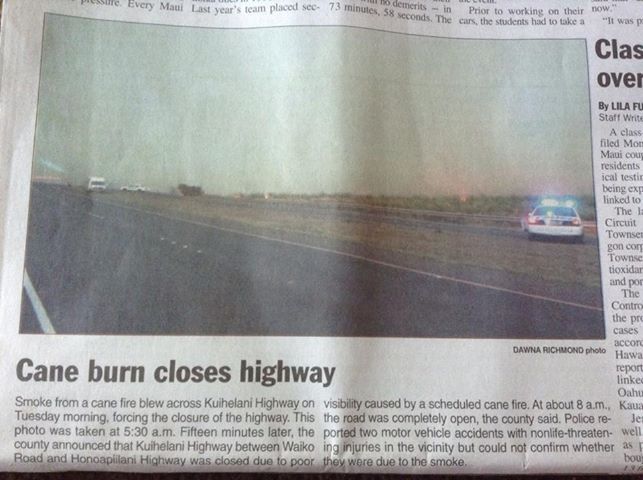Two car crashes on Maui on a smoke-obscured the highway highlight a three decade long battle between residents and the last sugarcane plantation in Hawai'i.

Agricultural burning on the mainland mostly takes place in sparsely populated areas and lasts only a few weeks. Sugarcane burning on Maui occurs daily 9 months out of the year. Subdivisions carved out of former sugarcane fields ajoin cane fields and entire towns are built next to the fields.
Coincidentally, sugarcane burning is stopped "for plant maintenance" during the tourist season from December through February.
Superficially, this may look like a simple fight between an agricultural operation which burns sugarcane before harvesting 9 months out of the year and an ever-encroaching population now being smothered in the smoke.

The fight is far more complicated. It pits Hawaii's most powerful union, International Longshore and Warehouse Union (ILWU), Hawaii's most powerful development corporation Alexander & Baldwin (A&B), the corrupt Cumberland Packing Corp (maker of Sugar in the Raw™) and political favors against the residents of Maui.
Since Maui's voters are only 85,000 of the state's 650,000 registered, its problems with daily smoke are not of interest to the majority of the State's legislators -- particularly since A&B, one of the original "Big Five" corporations controls the state and its politicians and is powerful on all the islands. A&B owns in shipping (Matson) and land development in addition to HC&S and its electrical generating plant.
In recent years the ILWU has embarked on a "If you can't beat 'em, join 'em" strategy of trading their member's influence and lobbying for unionization. A&B unionizes its development, shipping, electrical generation and agricultural operations and in return ILWU shows up and lobbies for zoning changes to allow A&B to convert precious farm land to development. Additionally ILWU members work hard phonebanking and signwaving for A&B friendly candidates.
It goes deeper than that since ILWU has organized a "construction union hui" (group) and increased their lobbying efforts on behalf of A&B with the Operators Union, IBEW, Carpenters Union and so on. Their lobbying efforts are available to any developer who will unionize. A&B is probably the largest of these developers.

For three decades Maui residents have been trying to stop the constant smoke from cane burning. They've been met with threats, racist insults (ILWU likes to maintain the fiction that it is only mainland "haoles" who object to smoke) and the cry that 800 jobs will be lost if A&B's agricultural company, HC&S, has to stop burning sugarcane.
All of this is untrue.
Last year a renewed campaign of writing to the EPA when smoke entered homes or obscured road visibility finally resulted in new criteria for burning. Previous to this the Maui employee of the Hawai'i Department of Health would walk out of his office after 8am some time and eyball 4 mountain peaks. If he could see even one peak, it was ok to burn. Ironically, this highly scientific meteorological method of determining whether to burn was processed after burning started at 4am or so.
The 2013 burn permit required that HC&S take into account actual conditions such as wind speed, inversion layers and Vog (volcanic smog) before burning.
This resulted in two months of 75% burn-free harvesting (March and April). These two months showed that HC&S's assertions that they needed new equipment and it would be too expensive to harvest without burning were flat out false. They harvested with their same antique equipment and methods.
Since HC&S escapes EPA pollution control standards by operating their coal-fired electrical generating plant (supplying 9% of Maui's electricity) by calling it a cogen "boiler" that burns sugarcane residue (bagass) the unburned cane leaves can be burned in the plants.
Anti-burn residents appealed to the New York, Cumberland Packing Corporation which manufactures Sugar in the Raw™ to pressure HC&S (A&B) to harvest without burning. Cumberland responded with the HC&S line that they were doing a favor for Maui by helping maintain jobs.
Residents then started an online petition begging Cumberland to ask HC&S to stop burning which has garnered 3117 signatures to date. They also started a Facebook cause to stop cane burning on Maui which garnered 5,679 members.
Meanwhile a physician at the State Department of Health initiated a study on health effects downwind of cane burning. After initially agreeing to participate, Maui Memorial (Maui's only hospital and recipient of A&B donations) backed out of the study.
"We know clearly that particle pollution is harmful at levels well below those previously deemed to be safe. Particle pollution causes premature deaths and illness, threatening the millions of Americans who breathe high levels of it,"
-- Norman H. Edelman, MD, Chief Medical Officer for the American Lung Association.
Which brings us to last Tuesday when HC&S burned next to the Kuihelani Hwy causing its closure at 5:30am and again at 1:30pm and resulting in two car crashes.
When Maui has one of the highest rates of asthma in the nation, when we lose 15 year olds to fatal breathing difficulties and thousands carry asthma inhalers with them, the problem with cane smoke can be covered up by A&B/HC&S by pressuring the hospital not to cooperate in studies.
But when HC&S cane burns close highways and cause crashes, it is time to say, "Stop!"
If you'd like to help pressure HC&S to no-burn harvest instead of ruining Maui people's health, please consider signing these petitions:
Sugar in the Raw, Stop Cane Burning on Maui
End Cane Burning on Maui


